An automated external defibrillator (defibrillator) is a portable device that analyses the heart’s rhythm and, if necessary, sends an electric shock (or defibrillation) to help re-establish a normal heart rhythm. Rapid access to a defibrillator can improve the chances of survival for those experiencing sudden cardiac arrest. A first aid provider who is able to give CPR can use a defibrillator with little or no training. Public access defibrillators are proven to be safe and effective, allowing defibrillation to take place immediately.
The automated devices have voice prompts and visual aids to follow and are easy to use. Once the defibrillator detects a shockable rhythm, it will automatically deliver a shock (fully automated defibrillator) or instruct the first aid provider to push the shock button (semi-automated defibrillator). A defibrillator does not replace the need for CPR. First aid providers must provide CPR with as few interruptions to chest compressions as possible while setting up and using the defibrillator.
_____________________________
NOTE
This topic should be used in conjunction with Unresponsive and abnormal breathing (adolescent and adult) or Unresponsive and abnormal breathing (baby and child).
_____________________________
Guidelines
- The implementation of public-access defibrillation programmes is recommended to improve the outcomes for people with out-of-hospital cardiac arrest. **
- For a person who is unresponsive with abnormal breathing (taking irregular or noisy breaths, or they stop breathing altogether), CPR should be provided until the defibrillator is ready to start analysing the heart. *
- For adults and children, automatic external defibrillation with self-adhesive pads can be used and is very safe. **
- For babies and children younger than eight years of age, a paediatric defibrillator should be used. **
- For babies and children younger than eight years of age, if a paediatric defibrillator or paediatric pads are not available, a standard defibrillator and pads could be used. *
- For adults and children (eight years or older), a standard defibrillator should be used. **
- Fast removal of excessive chest hair can be done before the application of pads, so long as the delay to shock delivery is minimal. *
- For optimal defibrillation in adults, pads greater than 8cm are more effective. *
- Pads should be placed on the chest according to the description given on the defibrillator or pads. For babies and children, the anterior-posterior placement of self-adhesive pads may be used (one pad on their front, and one pad on their back). *
- For large-breasted individuals, the left electrode pad should be placed beside or underneath the left breast, avoiding breast tissue. *
- First aid providers should continue to perform CPR while the defibrillator is set up and pause only when it is ready for analysis and, if indicated, provides a shock. **
- After the defibrillator administers a single shock, the first aid provider should resume with chest compressions immediately and not delay for rhythm reanalysis or a pulse check. Any pauses in chest compressions before and after the shock should be as short as possible. **
- When compared, biphasic waveforms are more effective than monophasic waveforms for terminating ventricular fibrillation. Purchasers of defibrillators should purchase biphasic automated external defibrillators. **
Good practice points
- In an oxygen-rich atmosphere (where high-flow oxygen is directed across the chest), first aid providers should ensure that defibrillation does not take place.
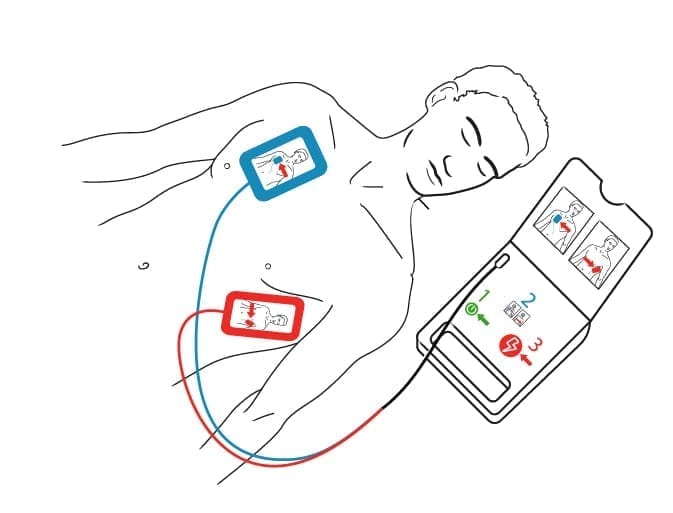
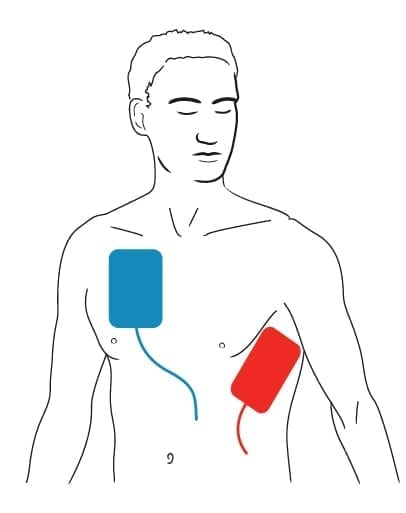
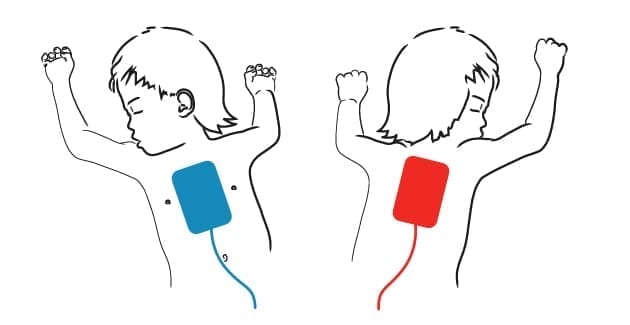
Chain of survival behaviours
Prevent and prepare
- Find out where the nearest defibrillators are near your places of work, home or recreation.
- Support or initiate public-access defibrillation programmes to increase the availability of defibrillators in public places, particularly in remote areas or those with longer EMS wait times.
- Advocate that large private organisations or facilities, including schools and universities, should have defibrillators accessible.
- Ensure that public access programmes are explicit that anyone can use a defibrillator and that you do not have to be a medical professional.
Early recognition
- A person is unresponsive with abnormal breathing.
- For more on this, see Unresponsive and abnormal breathing (adolescent and adult) or Unresponsive and abnormal breathing (baby and child).
First aid steps
- Begin CPR immediately.
- Ask a bystander to access emergency medical services (EMS), or if you are alone access EMS yourself. If using a phone, activate the speaker function.
- Ask a bystander to bring a defibrillator as quickly as possible.
- Use the defibrillator as soon as it is available. Follow the voice prompts, only pausing CPR when it is absolutely necessary.
- Continue CPR unless otherwise instructed to pause (either by the defibrillator or professional responder). Pause CPR if the person shows signs of recovery, such as signs of life (opening their eyes, speaking, crying or moving purposefully) or starts to breathe normally.
______________________________
NOTE
Defibrillation for babies and children
The following are the defibrillation preferences for babies and children. They should be used in the order provided (i.e., if option one is unavailable, then option two is acceptable).
- Paediatric defibrillator.
- Standard defibrillator with paediatric pads.
- Standard defibrillator with adult pads.
______________________________
NOTE
If you are alone and the defibrillator is visible in the immediate vicinity, you can leave the person to quickly get it.
______________________________
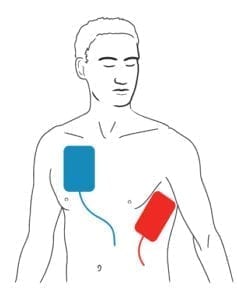 Placement of pads on adults and children over 8 years old.
Placement of pads on adults and children over 8 years old.
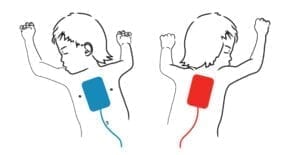 Placement of pads on babies and children under 8 years old.
Placement of pads on babies and children under 8 years old.
Access help
- Calling EMS is a priority after beginning CPR, ask a bystander to call or do it by yourself if you’re alone. Inform EMS if you are using a defibrillator.
- If accessing EMS via phone they should be able to guide you in CPR and how to use the defibrillator.
Self-recovery
- Even if the first aid provider has performed CPR and defibrillation and the person is now responsive and breathing normally, the person should continue to be closely monitored until they are assessed by a medical professional as they may stop breathing again.
Education considerations
Public access defibrillators
We recognise that public access systems globally may be at different stages of development, but the principle of early defibrillation remains a goal for any unresponsive person with abnormal breathing.
Context considerations
- Refer to and follow the guidance of regional resuscitation councils or other national protocols and tailor education accordingly.
- Consult local regulators to consider differences in regulation and liability protection for first aid providers.
- Where public access defibrillators are present, it is likely that onward medical care is also available. Therefore, learners in these contexts should be made aware of the presence of defibrillators and be empowered to use them.
- Where public access defibrillators are not available, first aid programmes should include information for the learner about how best to access onward care. Where onward care is not available first aid programmes need to equip the learner appropriately (see Unresponsive and abnormal breathing (adolescent and adult) or Unresponsive and abnormal breathing (baby and child).
- In contexts where video-assisted dispatcher support is available to first aid providers, prepare learners for what this is, and how it may help them. There is evidence this technology may further support first aid providers with accurate defibrillator use (e.g. pad placement and delivering shocks) as the video element allows dispatchers to monitor first aid provider actions and provide vital corrections if necessary (You et al., 2008).
Learner considerations
- When possible, educate school administrators and teachers on defibrillators to build their knowledge, skills and confidence before educating students. Doing so will encourage administrators and teachers to implement this type of education and increase their confidence in teaching students how to use a defibrillator (Zinckernagel et al., 2017).
- Include defibrillator education in first aid programmes for young people as well as adults (Zinckernagel et al., 2017).
Facilitation tips
- Advocate that public access defibrillators have clear signage and are placed in highly visible locations (Brooks et al., 2015; Winkle, 2010).
- Ensure learners are familiar with defibrillator signs and icons and can identify where to find one in their local context (Brooks et al., 2015).
- Emphasise that anyone can use an (automated) defibrillator, even someone who has never used one before. There are visual aids and voice prompts that will tell them what to do.
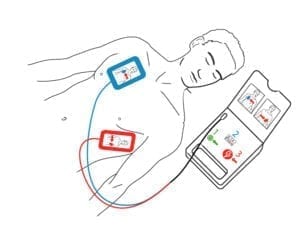 Defibrillators have voice prompts and visual aids to explain how to use them.
Defibrillators have voice prompts and visual aids to explain how to use them.
- Emphasise that a defibrillator will only shock someone if needed – it will never shock a healthy heart. If the defibrillator delivers a shock to the person, this does not always mean their heart will restart. The machine will detect whether the person’s heart has restarted and then give further instructions.
- Use scenario-based learning to provide learners with the opportunity to practise using a defibrillator. Practising will increase their confidence and willingness to act in an emergency.
- Have learners practise providing continuous CPR, minimising any interruptions, while another person sets up the defibrillator and applies the chest pads. Have them practise resuming CPR immediately after a pretend shock.
- Emphasise that time is critical to a successful outcome for the unresponsive person. Evidence indicates survival relies upon:
> immediate recognition that someone is unresponsive with abnormal breathing
> early access to help and access to EMS
> early high-quality CPR
> early defibrillation with an automated external defibrillator - Non-professional people can facilitate defibrillator education just as effectively as healthcare professionals (Castren et al., 2004).
Facilitation tools
Facilitating defibrillator skills
Rapid and good quality CPR remains essential to a successful outcome for an unresponsive person with abnormal breathing when a defibrillator is available. Emphasise the importance of CPR while practising the various techniques for successful defibrillation.
All defibrillators provide visual and verbal instructions, but some are fully automated, and some are semi-automated. The instructions below assume there is more than one first aid provider.
1. Begin CPR immediately. See Unresponsive and abnormal breathing (adolescent and adult) or (baby and child) for guidance on this.
2. Ask a bystander to access EMS, or if you are alone access EMS yourself. If using a phone, activate the speaker function.
3. Ask a bystander to bring a defibrillator as quickly as possible. If you are alone and the defibrillator is visible in the immediate vicinity, you can leave the person to quickly get it.
4. When the defibrillator arrives, if possible, one person should continue CPR while the other follows the defibrillator’s visual and voice prompts.
5. Apply the pads to the person’s skin on their chest as indicated by the instructions. It does not matter if the pads are in the reverse position. Do not remove them as this wastes time and they may not stick to the chest properly when reattached.
6. Once the defibrillator prompts that it is ready to analyse the heart rhythm, ensure no one is touching the unresponsive person. Press the button to begin the analysis.
7. If the machine indicates a shock is necessary, do not touch the person. Push the button to give a shock. (Fully automated defibrillators will shock automatically.)
8. Resume CPR immediately after the shock and follow the defibrillator’s prompts. Continue until a professional responder tells you to stop or the person shows signs of recovery (e.g., speaking, coughing, moving purposefully, opening their eyes) and starts to breathe normally.
Learning connections
- Learners must connect this topic with the CPR skills practise and knowledge building in Unresponsive and abnormal breathing (adolescent and adult) or (baby and child).
Scientific foundation
The concept of early defibrillation is well established in improving outcomes from cardiac arrest and there is no new evidence that goes against this principle.
CPR before defibrillation
ILCOR treatment recommendations are used for this scientific foundation (Olasveengen, 2020). Five randomised controlled trials were identified comparing a shorter with a longer interval of chest compressions before defibrillation. A range of outcomes were assessed including one-year survival with favourable neurological outcome and return of spontaneous circulation. When a short period of CPR was provided before shock delivery, the evidence showed no difference to any outcomes. Only one study found a favourable relationship between performing CPR for 180 seconds before defibrillation when the EMS response interval was five minutes or more. However, three other randomised controlled trials could not confirm this relationship. There is inconsistent evidence to support or refute providing a short period of CPR (1.5-3 minutes).
Rhythm check timing
See the summary in Unresponsive and abnormal breathing (adolescent and adult).
Self-adhesive defibrillation pads compared with paddles
There is no new evidence since 2010 so we have used the scientific foundation from the 2010 International Consensus on Cardiopulmonary Resuscitation and Emergency Cardiovascular Care Science with Treatment Recommendations (Sunde et al., 2010).
There’s very little evidence comparing the use of self-adhesive defibrillation pads to paddles for someone in cardiac arrest. Self-adhesive pads seem to be associated with a significantly improved rate of return of spontaneous circulation and hospital admission compared with hand-held paddles (Stults, 1987). Several studies showed the practical benefits of pads over paddles for defibrillation.
Pads size and placement for defibrillation
The 2010 ILCOR recommendations have been used for this topic (Sunde et al., 2010). No new evidence was identified in 2020 that modified the recommendations.
For the size of pads, one study demonstrated that increasing the pad size from 8 to 12 cm caused transthoracic impedance to decrease and shock success to increase (Dalzell, 1989). Other studies showed that larger paddle or pad sizes of the same diameter lowered transthoracic impedance. The chest wall size and anatomy limit the maximum paddle or pad size.
For placement studies, many positions of pads were studied. One study supports the anterior-posterior position, another study supports the anterior–lateral position and one study supports the anterior–apex position. At least five studies found no effect of electrode positioning, while one study showed that pads should be placed under the breast tissue. Two studies showed that hairy males should be shaved before the application of pads.
In summary, pads should be placed on the exposed chest in an anterior-lateral position, but it is acceptable for alternatives. Fast removal of excessive chest hair can be done before the application of pads.
Waveforms, energy levels, and strategies
The scientific foundation is based on the 2010 ILCOR recommendations (Sunde et al., 2010). These topics were not reviewed in 2020.
For the comparison of biphasic with monophasic defibrillation waveform, three trials and four human studies found that biphasic waveforms are more effective in terminating ventricular fibrillation. There is insufficient evidence to recommend any specific biphasic waveform. Nevertheless, in the absence of biphasic defibrillators, monophasic defibrillators are acceptable.
For the waveform and the energy level, there are insufficient quality human studies on the different waveforms and the energy use, making it difficult to make clear recommendations. It is proposed to start defibrillation at a selected energy level of 150–200 joules for a biphasic truncated exponential waveform.
There is also insufficient evidence to determine the initial energy levels for any other biphasic waveform. Although evidence is limited, because of the lower total shock success for monophasic defibrillation, initial and subsequent shocks using this waveform should be at 360 joules.
For the energy level of the second and subsequent biphasic shocks, the same initial energy level is acceptable. Studies of biphasic waveforms with varying strategies (fixed and escalating) and energy levels do not find clear evidence of the superiority of one strategy over another. It is reasonable to increase the energy level when possible.
Compared to three-stacked-shock protocols, one-shock protocols suggested significant survival benefit in three design studies and showed a significantly lower hands-off ratio (i.e., percentage of total CPR time when no compressions were provided). Studies also show that the success of the protocol is more dependent on the quality of CPR in different studies than the protocol used. So, when defibrillation is required, a single shock should be provided with the immediate resumption of chest compressions after the shock and chest compressions should not be delayed for rhythm reanalysis or pulse check immediately after a shock.
We did not find any significant survival differences between semi-automatic and manual defibrillation modes in resuscitation either in or out of the hospital. Manual defibrillation is associated with a lower total hands-off ratio. First aid providers delivered more shocks inappropriately with manual defibrillators. So, the semiautomatic mode is preferred for first aid providers.
There is no human data to confirm the superiority of fully or semi-automatic defibrillators.
Defibrillation near supplementary oxygen
In 2010, ILCOR completed an evidence summary that we used to form the scientific foundation for this topic (Sunde et al., 2010). Five case reports described instances where defibrillation attempts with paddles used in the vicinity of high-flow oxygen (greater than 10 litres per minute) generated sparks that caused fires. There were no case reports of fires when shocks were delivered using adhesive pads.
Two manikin studies found that oxygen concentration in the zone of defibrillation was not increased when the oxygen source was vented at least one metre behind the unresponsive person’s mouth. One study described higher oxygen concentrations and longer washout periods when oxygen was administered in confined spaces without adequate ventilation.
Analysis of rhythm during chest compressions
ILCOR recommendations are used for this scientific foundation (Olasveengen et al., 2020). Some modern defibrillators have filtering modes that allow visual or automated rhythm analysis during chest compressions. But we did not find studies that evaluated the effect of the artefact-filtering algorithms on any critical or important outcomes. The studies only assessed the feasibility and potential benefits of this technology. We found studies evaluating artefact-filtering algorithms in animal models of cardiac arrest and simulation studies. Though the result appears to be encouraging, none of these studies evaluated the use of this technology during actual cardiac arrest and resuscitation.
Public-access defibrillation
Two systematic reviews (Holmberg et al., 2017; Baekgaard et al., 2017) and the adult basic life support recommendations from ILCOR are used for this scientific foundation (Olasveengen, 2020). When we compare public access automated defibrillator programs versus systems with traditional EMS response, we can find that for the critical outcome of survival with favourable neurological outcome, one observational study showed an improvement after a public access defibrillator program at one year. Seven observational studies enrolling more than 40,000 people demonstrated an improvement after a public access defibrillator program at 30 days.
We also found that PAD programme improved hospital discharge with favourable neurological outcome, survival to 30 days, and survival to hospital discharge. In all cases, the evidence is low or moderate.
Automated external defibrillators for babies and children
Since the last recommendation for this topic in 2010 (Sunde et al., 2010), an update was performed by the Pediatric Basic Life support of ILCOR for the 2020 CoSTR. This update found insufficient evidence to make any changes to the 2010 recommendations.
Data has also shown there is a need for a defibrillator suitable for children and babies. Untreated ventricular fibrillation will lead to death in the absence of prompt defibrillation. Automated external defibrillators reduce the time to shock in many out-of-hospital settings, and first aid providers have successfully used defibrillators on babies. The algorithms used by automated external defibrillators have an acceptable safety and efficacy profile for babies.
For a child above 8 years, first aid providers should use a paediatric device. For a baby, the first aid providers should use an automated defibrillator with a dose attenuator. In all cases, if a specific device is unavailable, an adult defibrillator is acceptable, even for babies.
Energy doses for defibrillation
For this topic, we used the 2019 systematic review and the Pediatric Life Support 2020 International Consensus on Cardiopulmonary Resuscitation and Emergency Cardiovascular Care Science with Treatment Recommendations (Mercier et al., 2019; Maconochie, 2020).
In the 2015 consensus, an initial dose of 2 – 4 J/kg to treat shockable rhythms of cardiac arrest was recommended. For refractory ventricular fibrillation, guidelines recommend increasing the defibrillation dose to 4 J/kg, suggesting that subsequent energy doses should be at least 4 J/kg and noting that while higher levels may be considered, not to exceed 10 J/kg. A single 2019 systematic review of paediatric human and animal studies identified no studies linking the initial or cumulative energy delivered to survival to hospital discharge and no link between long-term survival or survival with good neurological outcome. Meta-analysis could not be performed.
In June 2020, a new study of energy doses for paediatric defibrillation found that for babies and children with in-hospital cardiac arrest and initial ventricular fibrillation. First shock energy doses other than 1.7 to 2.5 J/kg were associated with lower survival to hospital discharge among the 301 people 12 years of age or younger with initial ventricular fibrillation, and first shock doses more than 2.5 J/kg were associated with lower survival rates in people 18 years of age or younger with initial ventricular fibrillation. With this last study and for ease of teaching, a dose of 2 J/kg seems to be a good practice.
Paddles position, size and orientation
This topic’s scientific foundation came from an evidence summary completed by ILCOR in 2010 (de Caen et al., 2015). We did not identify sufficient evidence since 2010 to change the treatment recommendations. Paediatric studies demonstrated that transthoracic impedance decreased when pad size increased independently with pad positioning. One paediatric study found no difference in the rate of return of spontaneous circulation between anterolateral and anteroposterior electrode positioning during shock delivery.
Education review
We looked for evidence which contained insights on education considerations on the use of defibrillators. From 22 papers that appeared in our search, we identified five for review.
Educating school administrators and teachers
Zinckernagel et al. (2017) ran a qualitative study using semi-structured interviews and focus groups with 25 participants including nine school leaders and 16 teachers from eight different secondary schools in Denmark. Overall, the results indicated that educating school administrators and teachers about defibrillators affects their attitudes and acceptance of defibrillators within school settings. The perceived ease of use of defibrillators by the participants in this study is correlated with their familiarity with defibrillators. Additionally, participants believed defibrillator education to be helpful but were unclear whether secondary school-aged students should have defibrillator education and access to these devices. These findings identify that school educators are ‘gatekeepers’ for how and if student defibrillator education will be implemented in schools. It suggests that defibrillator education should be given first and foremost to school administrators and teachers, prior to implementing student education. Educator attitudes and acceptance of defibrillators is crucial to successful defibrillator student education within schools and the overall perception of defibrillator ease of use. Moreover, this study demonstrates that schools may not be aware that defibrillator education is safe and appropriate for students.
Placement of defibrillators
Winkle (2010) compares the use of defibrillators within various settings and highlights that defibrillators are most effective and cost-effective when placed in environments which have a high number of people passing through (e.g. airports, casinos, health clubs). Additionally, the author finds that defibrillators in a community or individual residences are less likely to be used and do not change the rate of resuscitation. These findings suggest that if defibrillators are placed in certain public settings, the public should be made aware of their existence, location, and how to use them.
Brooks et al. (2015) examine whether low rates of public access defibrillator use by bystanders are attributed to public confidence and knowledge. The study took place at a busy shopping centre in the United Kingdom. Using semi-structured interviews and open-ended questions, 1004 participants, ranging in age from 9-90, answered questions about first aid education, basic life support and defibrillator knowledge. They were also given a scenario involving witnessing someone who had collapsed and was unresponsive and asked to describe step-by-step their actions. A majority of participants (79%) reported that they had knowledge of what to do in if someone was not breathing and knew what a public access defibrillator was. However, only 26.1% of participants knew how to use a defibrillator. Just 5.1% of participants knew how to locate the nearest public access defibrillator and 3.2% said they would try to locate a defibrillator. Only 2.1% would attempt to find the defibrillator and use it in a cardiac arrest emergency. The findings of this study indicate that low defibrillator use stems from inadequate public access defibrillator awareness, education and confidence, rather than a lack of defibrillators installed in public settings. The authors suggest that defibrillators are not marked well or placed in highly visible locations, therefore impacting public knowledge of their existence. Moreover, previous first aid education influenced the rate at which participants were able to locate defibrillators and their willingness to retrieve and use them.
Professional healthcare instructors versus non-healthcare-professional instructors
Castren et al. (2004) compare the resuscitation skills of learners educated by non-healthcare-professionals compared to healthcare professionals. All learners (n=38) had no previous defibrillator experience. Ten pairs of learners were educated by four newly educated non-healthcare-professional instructors and the other nine pairs were educated by four healthcare professionals. All eight instructors provided a four-hour course in basic lifesaving and defibrillator skills and then after two weeks, they received a four-hour instructor course. All learners participated in two scenarios and used a trainer-defibrillator and a manikin. Each pair was assessed with a 49-point checklist. A control group of trained first aid staff from the Red Cross was used.
Results showed no difference in the performance rates of learners educated by non-healthcare-professionals and those educated by healthcare professionals. However, the nearly 100% correct performances of the educated first aid control group highlighted the importance of the continuous and frequent practise of basic lifesaving and defibrillator skills – this group practised basic lifesaving and defibrillator skills every two weeks. This study suggests that non-healthcare-professionals can deliver basic lifesaving and defibrillator skills education just as effectively as healthcare professionals. Non-healthcare-professionals may have more capacity than healthcare professionals to engage in education, and they may be able to educate others in the community on a larger scale. There is a need for improved and confident timing of step-by-step actions (e.g. positioning of pads for defibrillation) by learners. As timing is crucial for optimal effectiveness of care, this may be something to specifically address when educating.
Dispatcher-assisted-video
You et al. (2010) examine whether the approach of providing defibrillator instructions for untrained first aid provider via dispatcher-assisted video phone technology improves the success of defibrillator use. 52 public officers with no previous defibrillator education or experience were recruited for this study. All participants were provided with a universal prompt, a phone with video capacity, a trainer-defibrillator, and a dressed manikin to simulate an unresponsive person with abnormal breathing. All participant phones were connected with an emergency dispatcher using the same video phone technology. The results suggest that video-assisted phone technology may further support first aid providers with accurate defibrillator use (e.g. pad placement and delivering shocks) as the video element allows dispatchers to monitor first aid provider actions and provide corrections if necessary.
References
Systematic reviews
Bækgaard, J. S., Viereck, S., Møller, T. P., Ersbøll, A. K., Lippert, F., & Folke, F. (2017). The effects of public access defibrillation on survival after out-of-hospital cardiac arrest: a systematic review of observational studies. Circulation, 136(10), 954-965.
de Caen, A. R., Maconochie, I. K., Aickin, R., Atkins, D. L., Biarent, D…. Guerguerian, A.-M., (2015). Part 6: Pediatric Basic Life Support and Pediatric Advanced Life Support: 2015 International Consensus on Cardiopulmonary Resuscitation and Emergency Cardiovascular Care Science With Treatment Recommendations. (Vol. 132, pp. S177–203). Presented at the Circulation, Lippincott Williams & Wilkins Hagerstown, MD.
http://doi.org/10.1161/CIR.0000000000000275
Holmberg, M. J., Vognsen, M., Andersen, M. S., Donnino, M. W., & Andersen, L. W. (2017). Bystander automated external defibrillator use and clinical outcomes after out-of-hospital cardiac arrest: A systematic review and meta-analysis. Resuscitation, 120, 77-87.
Kuzovlev A, Mancini MB, Avis S, Brooks S, Castren M, Chung S, Considine J, Kudenchuk P, … Olasveengen, T. M. (2019). Analysis of rhythm during chest compression during Cardiac Arrest in Adults Consensus on Science with Treatment Recommendations [Internet] Brussels, Belgium: International Liaison Committee on Resuscitation (ILCOR) Basic Life Support Task Force. Available from:
http://ilcor.org
Maconochie, I. K., Aickin, R., Hazinski, M. F., Atkins, D. L., Bingham, R., Couto, T. B., … & Ong, G. Y. (2020). Pediatric Life Support: 2020 International Consensus on Cardiopulmonary Resuscitation and Emergency Cardiovascular Care Science With Treatment Recommendations. Circulation, 142(16_suppl_1), S140-S184.
Mercier, E., Laroche, E., Beck, B., Le Sage, N., Cameron, P. A., Emond, M., … & Ouellet-Pelletier, J. (2019). Defibrillation energy dose during pediatric cardiac arrest: Systematic review of human and animal model studies. Resuscitation, 139, 241-252.
Olasveengen, T. M., Mancini, M. E., Perkins, G. D., Avis, S., Brooks, S., Castrén, M., … & Hatanaka, T. (2020). Adult basic life support: 2020 International Consensus on Cardiopulmonary Resuscitation and Emergency Cardiovascular Care Science with Treatment Recommendations. Circulation, 142(16_suppl_1), S41-S91.
Perkins, G. D., Travers, A. H., Berg, R. A., Castren, M., Considine, J., Escalante, R., et al. (2015). Part 3: Adult basic life support and automated external defibrillation: 2015 International Consensus on Cardiopulmonary Resuscitation and Emergency Cardiovascular Care Science with Treatment Recommendations. Resuscitation, 95, e43–69. DOI: http://doi.org/10.1016/j.resuscitation.2015.07.041
Ristagno G, Olasveengen TM, Mancini MB, Avis S, Brooks S, Castren M, Chung S, Considine J, Kudenchuk P, Perkins G, Semeraro F, Smyth M, (2019). Rhythm check timing Consensus on Science with Treatment Recommendations, Basic Life Support Task Force. Brussels, Belgium: International Liaison Committee on Resuscitation, Dec 28th. Available from:
http://ilcor.org
Sunde, K., Jacobs, I., Deakin, C. D., Hazinski, M. F., Kerber, R. E., Koster, R. W., … & Sayre, M. R. (2010). Part 6: Defibrillation: 2010 international consensus on cardiopulmonary resuscitation and emergency cardiovascular care science with treatment recommendations. Resuscitation, 81(1), e71-e85.
Travers, A. H., Perkins, G. D., Berg, R. A., Castren, M., Considine, J., Escalante, R., et al. (2015). Part 3: Adult Basic Life Support and Automated External Defibrillation. Circulation, 132 (16 suppl 1), S51–S83.
http://doi.org/10.1161/CIR.0000000000000272
Non-systematic reviews
Dalzell, G. W., Cunningham, S. R., Anderson, J., & Adgey, A. J. (1989). Electrode pad size, transthoracic impedance and success of external ventricular defibrillation. The American journal of cardiology, 64(12), 741-744.
Gold, L. S., Fahrenbruch, C. E., Rea, T. D., & Eisenberg, M. S. (2010). The relationship between time to arrival of emergency medical services (EMS) and survival from out-of-hospital ventricular fibrillation cardiac arrest. Resuscitation, 81(5), 622-625.
Stults, K. R., Brown, D. D., Cooley, F., & Kerber, R. E. (1987). Self-adhesive monitor/defibrillation pads improve prehospital defibrillation success. Annals of emergency medicine, 16(8), 872-877.
Education references
Brooks, B., Chan, S., Lander, P., Adamson, R., Hodgetts, G. and Deakin, C. (2015). Public knowledge and confidence in the use of public access defibrillation. Heart, 101(12), pp.967-971. Full article: https://www.researchgate.net/profile/Charles_Deakin/publication/275667328_Public_knowledge_and_
confidence_in_the_use_of_public_access_defibrillation/links/55acef0208ae815a042b3c46.pdf
Castrén, M., Nurmi, J., Laakso, J., Kinnunen, A., Backman, R. and Niemi-Murola, L. (2004). Teaching public access defibrillation to lay volunteers—a professional health care provider is not a more effective instructor than a trained lay person. Resuscitation, 63(3), pp.305-310. Abstract: https://www.sciencedirect.com/science/article/abs/pii/S0300957204002709
Winkle, R. (2010). The Effectiveness and Cost Effectiveness of Public-Access Defibrillation. Clinical Cardiology, 33(7), pp.396-399. Full article:
https://onlinelibrary.wiley.com/doi/pdf/10.1002/clc.20790
You, J., Park, S., Chung, S. and Park, J. (2008). Performance of cellular phones with video telephony in the use of automated external defibrillators by untrained laypersons. Emergency Medicine Journal, 25(9), pp.597-600. Full article:
http://citeseerx.ist.psu.edu/viewdoc/download?doi=10.1.1.848.7527&rep=rep1&type=pdf
Zinckernagel, L., Hansen, C., Rod, M., Folke, F., Torp-Pedersen, C. and Tjørnhøj-Thomsen, T. (2017). A qualitative study to identify barriers to deployment and student training in the use of automated external defibrillators in schools. BMC Emergency Medicine, 17(3). Full article:
https://link.springer.com/article/10.1186/s12873-017-0114-9
Related topics
Explore the guidelines
Published: 15 February 2021

First aid
Explore the first aid recommendations for more than 50 common illnesses and injuries. You’ll also find techniques for first aid providers and educators on topics such as assessing the scene and good hand hygiene.

First aid education
Choose from a selection of some common first aid education contexts and modalities. There are also some education strategy essentials to provide the theory behind our education approach.

About the guidelines
Here you can find out about the process for developing these Guidelines, and access some tools to help you implement them locally.
